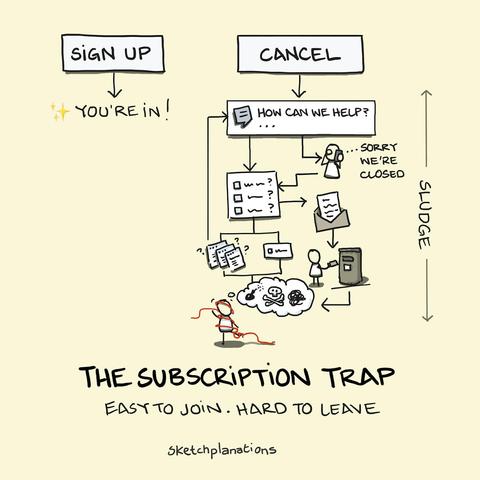#Business #Pitfalls
The subscription trap · It’s easy to join, but hard to leave https://ilo.im/163i85
_____
#Email #Subscription #DarkPattern #DeceptiveDesign #ProductDesign #UxDesign #WebDesign

#Business #Pitfalls
The subscription trap · It’s easy to join, but hard to leave https://ilo.im/163i85
_____
#Email #Subscription #DarkPattern #DeceptiveDesign #ProductDesign #UxDesign #WebDesign

Windows hat erkannt, dass sie Linux installieren wollen. Sollen wir den Vorgang abbrechen?
New #DarkPattern spotted! Is it any wonder why most people just click "I accept" and move on?
Solution: give an easy "No, thanks" button on the initial popup. And if you *must* have a dedicated page, have two separate, clearly labeled buttons for agree and disagree. It's not that hard, do better.
Aller, tu cliques "Supprimer le contact", MailChimp ouvre une fenêtre "Archiver le contact" avec marqué en bas "Plutôt supprimer le contact".
Mais quel enfer.
@bertl94 @kuketzblog Das dürfte illegal sein. Ich könnte mir allerdings vorstellen, das beim Seitenaufrufe die Regler verschoben werden ("Ist unser Standard") und wenn man's nicht ändert war's das. #darkpattern
LinkedIn keeps abusing notifications for games promotions. They’re turned off now. #LinkedIn #DarkPattern #userExperience
An example of frustration with Google.
Google added a compulsory "system browser" to my Android.
Should be a no-frills unowned Internet browser, right?
Sorry, read the privacy policy. It's a company data harvester for some random shell company.
That's a dark pattern!
#darkPattern #Google #Android
Ey, @tazgetroete !
Ich hoffe, der Cookie-Banner mit den 617 (!) Partnern und #Darkpattern ist nur ein schlechter Joke! Wenn der bleibt, ist mein #tazzahlich-Beitrag (und ich) wieder weg!
Advies van @universiteitleiden "Gebruik WhatsApp niet voor zakelijke berichten" Heel goed! dat gaat vooruit.
https://www.medewerkers.universiteitleiden.nl/mededelingen/2025/02/gebruik-whatsapp-niet-voor-zakelijke-berichten
Nu #MSTeams nog afraden, want daar gelden vrijwel dezelfde problemen voor als voor #WhatsApp, zeker als er een deelnemer is die níet onder de verwerkersovereenkomst van de universiteit valt.
Eén verkeerde klik in de dark pattern slalom en je hebt zogenaamd "geïnformeerde toestemming" gegeven aan Microsoft.
It's the pre-conference waiting music while attendees navigate the unintentional #darkpattern of the stubborn AV touchscreen interface https://www.youtube.com/watch?v=_ozy1EcB9kY
Actually, dark patterns do exist on #Mastodon. We don’t recognize them as dark patterns because we’re too politicized to see what’s obvious in plain sight.
But here’s an example of a #darkpattern on Mastodon: harassers being able to send you abusive messages as “followers only”. This renders the message invisible from public view while being visible to everyone who follows the abuser – followers who are likely to have the same toxic affinity as the abuser.
Let’s not pretend this is not a dark pattern. It clearly is.
RE: https://mastodon.social/users/harryprayiv/statuses/114082840668402297
Built for Mars case study on "How Airline Checkouts Deceive You" https://builtformars.com/case-studies/flights-chapter-3
#uxdesign #darkpattern #money
As I am in the process of cancelling it, here's a view of the current UK #Disney Plus subscription prices. As you can see they now have the #enshittification option of "with ads". Presumably the "ad-free" will have ads soon too. Being a #darkpattern based design, this "change your plan" page of course lacks any option to pause or cancel my subscription. The hunt begins...
@goodenough for sure but it's def a #darkpattern trend I've noticed, started I'm pretty sure by Microsoft with...with...at least Windows 8, nagging and even resetting options. I think it got worse in windows 10 or 11.
Sheesh you'd think I'd dedicate more of my brain to "which operating system sucked the most"
@mike no, this is intentional, just like any other #DarkPattern use designed to nudge #TechIlliterates into #Office365 and ither #subscriptions!
För många av apparna så måste jag också ta mig igenom kakmonstret, om allt de vill damsuga mig på.
Från erfarenhet så är det värt besväret lägga upp till minuter, som de värsta syndarnas #DarkPattern består av. Där särskilt bakdörren #BerättigatIntresse sticker ut. Väldigt vanligt allt är påslaget som standard där, även om allt annat som standard är avslaget. Det är så utstuderat dåligt så det skriker!
Belöningen är inte bara mindre störning - ofta märks tydlig prestandaförbättring
#Flickr c'est vraiment bof, même pas moyen de supprimer son compte.
Merci pour le #DarkPattern !
@mattwilcox yep.
e.g. I think it’s safe to say that the plan to put the US Treasury on a blockchain is a very #darkPattern indeed https://www.forbes.com/sites/digital-assets/2025/02/02/this-needs-to-stop-now-elon-musk-confirms-radical-doge-us-treasury-plan/
It is really disgusting that #Apple is still trying to sell me their "Apple Pay" service with EACH and EVERY iOS upgrade.
And even more disgusting that I cannot remove that crap warning.
I DO NOT WANT TO USE APPLE PAY. EVER. REALLY!
Shame on you, Tim Apple.
@Gords @nixCraft personally I think #PayOrOkay and other #DarkPattern bs should be outlawed and only explicit #OptIn without #paywalling allowed!